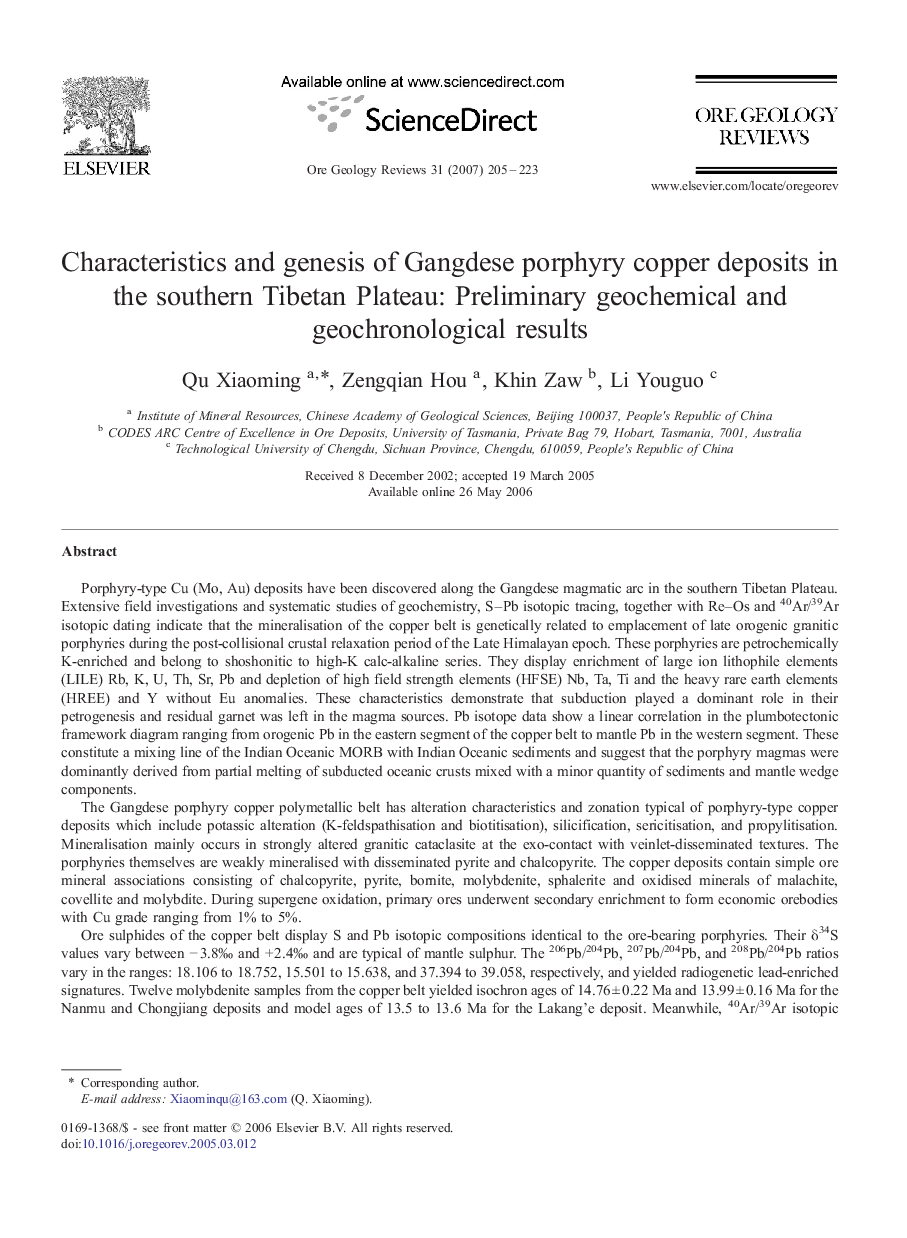| کد مقاله | کد نشریه | سال انتشار | مقاله انگلیسی | نسخه تمام متن |
|---|---|---|---|---|
| 4697953 | 1637270 | 2007 | 19 صفحه PDF | دانلود رایگان |

Porphyry-type Cu (Mo, Au) deposits have been discovered along the Gangdese magmatic arc in the southern Tibetan Plateau. Extensive field investigations and systematic studies of geochemistry, S–Pb isotopic tracing, together with Re–Os and 40Ar/39Ar isotopic dating indicate that the mineralisation of the copper belt is genetically related to emplacement of late orogenic granitic porphyries during the post-collisional crustal relaxation period of the Late Himalayan epoch. These porphyries are petrochemically K-enriched and belong to shoshonitic to high-K calc-alkaline series. They display enrichment of large ion lithophile elements (LILE) Rb, K, U, Th, Sr, Pb and depletion of high field strength elements (HFSE) Nb, Ta, Ti and the heavy rare earth elements (HREE) and Y without Eu anomalies. These characteristics demonstrate that subduction played a dominant role in their petrogenesis and residual garnet was left in the magma sources. Pb isotope data show a linear correlation in the plumbotectonic framework diagram ranging from orogenic Pb in the eastern segment of the copper belt to mantle Pb in the western segment. These constitute a mixing line of the Indian Oceanic MORB with Indian Oceanic sediments and suggest that the porphyry magmas were dominantly derived from partial melting of subducted oceanic crusts mixed with a minor quantity of sediments and mantle wedge components.The Gangdese porphyry copper polymetallic belt has alteration characteristics and zonation typical of porphyry-type copper deposits which include potassic alteration (K-feldspathisation and biotitisation), silicification, sericitisation, and propylitisation. Mineralisation mainly occurs in strongly altered granitic cataclasite at the exo-contact with veinlet-disseminated textures. The porphyries themselves are weakly mineralised with disseminated pyrite and chalcopyrite. The copper deposits contain simple ore mineral associations consisting of chalcopyrite, pyrite, bornite, molybdenite, sphalerite and oxidised minerals of malachite, covellite and molybdite. During supergene oxidation, primary ores underwent secondary enrichment to form economic orebodies with Cu grade ranging from 1% to 5%.Ore sulphides of the copper belt display S and Pb isotopic compositions identical to the ore-bearing porphyries. Their δ34S values vary between − 3.8‰ and + 2.4‰ and are typical of mantle sulphur. The 206Pb/204Pb, 207Pb/204Pb, and 208Pb/204Pb ratios vary in the ranges: 18.106 to 18.752, 15.501 to 15.638, and 37.394 to 39.058, respectively, and yielded radiogenetic lead-enriched signatures. Twelve molybdenite samples from the copper belt yielded isochron ages of 14.76 ± 0.22 Ma and 13.99 ± 0.16 Ma for the Nanmu and Chongjiang deposits and model ages of 13.5 to 13.6 Ma for the Lakang'e deposit. Meanwhile, 40Ar/39Ar isotopic dating of two biotite phenocrysts from the Chongjiang and Lakang'e deposits give plateau ages of 13.5 ± 1.0 Ma and 13.42 ±0.10 Ma, respectively. During the geodynamic evolution of the Gangdese collision-orogenic belt, intrusion of the ore-bearing porphyries took place just before the rapid uplift and E–W extension of the southern Plateau. And the ore-forming process may have occurred simultaneously with the uplift and extension (14 ± 0.1 Ma).
Journal: Ore Geology Reviews - Volume 31, Issues 1–4, April 2007, Pages 205–223